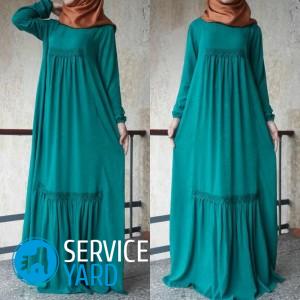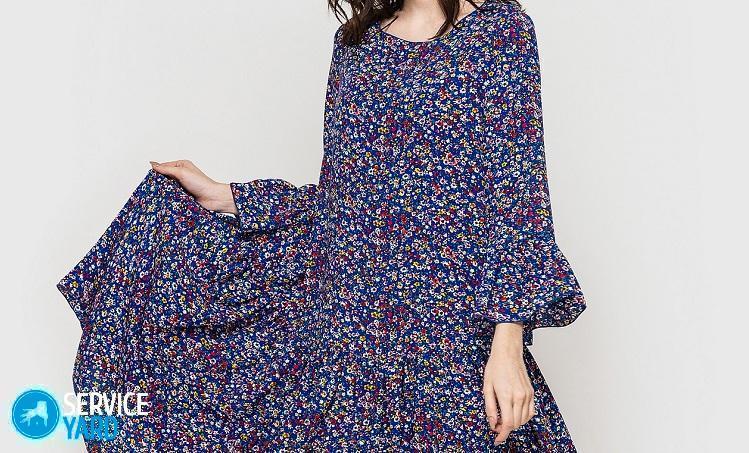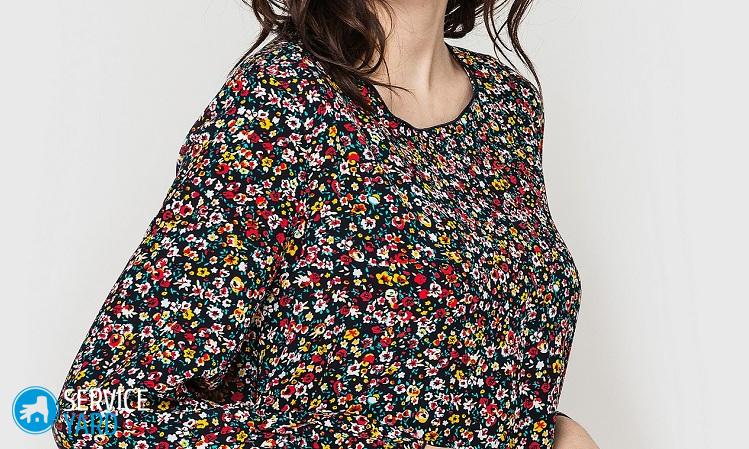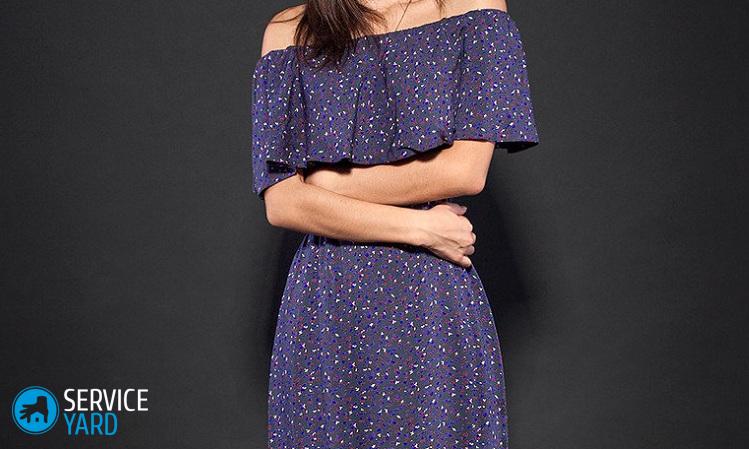Styles of summer dresses made of staple 🥝 with tiers, photo

Everyone has heard of such material as chintz, calico, cotton or silk. But the staple was undeservedly forgotten. This lightweight fabric was at the peak of popularity in the middle of the last century. Not a single Soviet fashionista could do without a dress from this fabric in her wardrobe. Over time, it was replaced by other varieties of materials, more complex and textured. But now the staple is undergoing a rebirth. After all, this lightweight material does not crease, gives comfort in hot weather, is ideal for long dresses, creating a beautiful silhouette, and the fabric is quite inexpensive. Therefore, let us not only carefully consider this type of material, but also learn how to sew a dress from a staple with our own hands.
to contents ↑Composition and benefits of fabric
The staple in recent years has again gained leadership positions. Now it is one of the favorite materials among buyers and among manufacturers of light industry. The fabric has a traditional plain weave, but it also uses shortened fibers.
Important! As a raw material, even waste from the production of other fabrics where only long fiber is needed can be used.
Usually the staple is of two types.
- Cotton. By the name it is clear that the fabric consists of 100 cotton. Due to this, it lets in more air, does not cause irritation, the fabric has a thin, soft and pleasant to the touch structure. True, this type of material has its drawbacks - it does not stretch and creases strongly.
- Classic or mixed look. In its composition, cotton is mixed with viscose and lavsan, which allows you to get almost non-wrinkled fabric.
This fabric, which is most often chosen in order to sew a dress from a staple with your own hands, also has a number of advantages that distinguish it from other materials.
- This material is environmentally friendly, it has no chemical or toxic additives, so it is absolutely safe for health.
- Thanks to what is said above, the material is antibacterial and hypoallergenic.
- The staple structure lets air through, allowing the skin to breathe freely without steaming, even on a hot day, while giving a feeling of coolness and comfort.
- It is also hygroscopic, absorbs moisture well, cooling the skin.
- Due to the properties of cotton and viscose, the fabric is perfectly dyed and retains color for a long period of time - it does not fade, does not fade, does not stretch. Colors, as new, even after numerous washings.
- The staple has excellent tactile characteristics. It is soft, light, elastic, pleasant to the touch.
to contents ↑Important! If you are going to sew a dress from a staple, then choosing the color you like is not difficult. This material has the most beautiful prints and their colors among all other fabrics. His prints range from a small flower to large floral prints and paisley, as on Pavlovo Posad shawls.
Care Features
Since the staple is a natural material, it has its own characteristics, which must be taken into account before you are ready to sew a dress from the staple with your own hands:
- This material can only be washed in delicate mode or by hand, at temperatures up to 40 ° C.
- Detergent should be gentle, not containing any aggressive substances, otherwise - you risk losing the saturation of the print.
- It is better to squeeze a dress or skirt out of the staple with your own hands also not in the typewriter, since when wet, the staple is easy to damage.
- This fabric needs to be ironed from the wrong side, preferably through gauze or other fabric.
to contents ↑Important! Of particular note is the fact that the staple gives significant shrinkage. If you are going to sew a dress from a staple, then before cutting the fabric, the cut must be subjected to wet-heat treatment. And not just iron it, but moisten the fabric and let it dry. It is then that shrinkage will manifest itself fully. Otherwise, washing your finished dress from a staple with your own hands, you risk getting a thing one size smaller.
Fit silhouette
A dress for cold weather from this thin fabric will not be entirely appropriate. But the ability of the staple to cool the skin in the heat makes it indispensable when sewing summer dresses, so we will consider options for styles that are best suited for a dress made of staples with your own hands:
- A-silhouette model just above the knee. The neckline is made shallow, semicircular or square in shape. Sleeves are sewn in the form of flashlights or wings.
- Dress dress straight cut. The length can be either slightly above the knee, or to the middle of the calf. Short models are suitable for girls, elongated - for adult ladies. The neckline is made quite closed in the form of a boat, droplets with ties.
- The direct silhouette of a dress made of staple with their own hands suits girls with three-dimensional shapes. The free cut does not fit the figure, the elongated model will make the figure visually slimmer. The hem of the dress is decorated with braid, lace, embroidery.
- A trapezoidal model above the knee. The dress does not have sleeves or they are made in the form of a small wing or a bat. An unusual image will create a model with a flower bud pattern in the middle of the product.
- Patchwork outfits made from staple free cut. A colorful product suits ladies with any type of appearance. A harmonious ensemble will make such a model in combination with woven bags, wide hats, red jewelry.
- A long sundress in combination with a bottom shirt sewn from cotton or linen. The sundress has a tight bodice, high waist line. The neck is attached, the cut is made semicircular or square.
- An elongated model with a small boat-shaped neckline and a fitted bodice. The sleeve is made long below the elbow or to the wrist of a tight-fitting shape, a little to pick up at the armhole. The skirt flares from the waist and reaches the ankles.
- Loose outfit shirt silhouette. The length of the model reaches the ankles. A triangular scarf can be used as a belt.
to contents ↑Important! Not only slender girls can have a sewn dress from a staple with their own hands in the wardrobe. Ladies with curvaceous forms will be able to choose for themselves a suitable option that will not add extra volume. The fabric drapes well, forms soft folds, so flared staple skirts look very nice, do not make the figure heavier.
Suitable accessories
Since the staple is lightweight and mostly mottled, you need to consider that not all accessories are suitable for it. Here are some tips that stylists give to those who are already starting to look for patterns of dresses from a staple with their own hands:
- To create an everyday look, wear gladiator sandals, flat sandals with such dresses, and flip flops and a sundress from staples are suitable for holidays.
- Shortened models look good with shoes on a high wedge, evening and cocktail options accept stilettos.
- A plain staple dress in a simple design can be worn in the office in the heat, complementing it with beige shoes with a closed cape.
to contents ↑Important! Of the accessories for such a dress, wide-brimmed hats, hair bands, braided belts and bags, clutches, wooden jewelry and jewelry with ethnic motifs are suitable. The evening look can be complemented with pearls or silver jewelry.
The subtleties of working with a staple
Just say that to sew a dress from a staple under the force of any of you. Even those who have just begun to master sewing skills will cope with this. This material in the work is quite obedient, it can be easily cut, but it also has its own nuances:
- The staple, like flax, is a fairly loose fabric. Therefore, in order to strengthen the future product and give it a neat appearance, the seams are made with closed sections, in the castle - French or linen.
- If you have not yet mastered such sewing operations and have not studied the varieties of all seams, then do as follows. After you have connected the details of the future dress on a regular typewriter, for example, on the shoulders, then the seams must be processed on an overlock. The zigzag seam will not fit here, it will not be able to fix the fibers well enough, and after the first wash, the seams will look messy, since the threads will stick out from the edge of the fabric.
- In the process of sewing a skirt from a staple with your own hands, using technology, you need to iron the seams. And this operation on this material should be done only through cheesecloth or with the steaming function, since the fabric can sparkle.
Sewing
In order to start sewing, you will need to do a dress pattern from a staple with your own hands. But it all depends on the complexity of your chosen model. We suggest considering several options - with and without patterns.
Staple Sundress
The simplest option is a basic maxi-length summer dress, sewn from two large squares of fabric. It is suitable for any complexion and will effectively look on magnificent figures with noticeable bends.
For such a model you will need:
- a piece of material about 300x150 cm;
- a decorative cord in tone - one and a half meters;
- pins, sewing machine;
- buttons - to secure the hem.
We cut off the edges of the prepared fabric, they tighten the fabric of the material and can interfere with asymmetric cutting. Then fold the cut in half and cut it. Having received two squares, it is worth immediately processing them on the overlock at the edges so that the fabric does not crumble in the process of further work. We don’t do anything else to cut off or cut off in the process of sewing a dress from a staple with our own hands, but act according to the following scheme.
- We sweep two panels so that the axis between the corners is in the middle of the front. The distance convenient for walking is determined during the fitting.
- During this process, we determine the length of the armhole and the location of the shoulder seams. If necessary, we make chest tucks or soft folds.
- We determine the length of the shoulder seam - this segment should be no more than 5 cm.
- We make a basting by hand and a second fitting to make sure that everything is in place, and in order to insert cords into the formed corners to fix the dress on the shoulders.
- After the second fitting, we lay the machine line on the wrong side of the fabric.
- We collect the free edges with sewn cords and wrap them on the back so that they can be tied into a beautiful knot.
As a result, we get a free sundress dress from a staple with our own hands. The fabric is held on the shoulders by two seams, and an acute angle along the hem can be attached to the front to create a soft line of the skirt along the bottom, using the most ordinary button for this.
Model with a skirt-sun
A full skirt and a defined waistline are a classic combination adored by many girls. The skirt in such dresses is:
- with assembly - it is done quickly and simply, but gives the skirt a beautiful, magnificent volume;
- with folds that can be oncoming or looking in different directions;
- the sun or the sun - which anyone can tailor.
Important! After taking measurements and designing a drawing by size, you need to cut the fabric according to the pattern.Do not forget to add allowances for the seams, along the main lines - 1 cm, on the bottom of the hem and sleeves - 4 cm. You can lay out the details of the dress from the staple with your own hands with any share.
Then step by step we perform the following operations!
- Grind the armhole and neck, grind and iron the tucks.
- Sweep and grind the side seams on the bodice, leaving a patch for the zipper.
- Stitch and iron seams on the shoulders.
- Sew along the oblique cut with cuts on the armhole and neck.
- Stitch the skirt seam by pulling it with your hand down from the waist and leaving a section under the zipper.
- Manually assemble at the waist allowance and iron, remembering to use the steaming function or gauze.
- Align the side cut along the bottom of the bodice and the top of the skirt, fasten with pins.
- Sew the top of the product and insert the zipper.
- At the last stage, start aligning the bottom of the skirt. When making sure that all the edges are symmetrical, hem the fabric and steam it.
Your do-it-yourself staple dress is done!
Dress to the floor
One of the most beloved and popular styles for a dress from a staple with your own hands is a floor model, free, but emphasizing the figure. In such a style, a frill is made, giving things originality. To create such a dress you will need:
- Two rectangular cuts of fabric, equal in width to half the circumference of the chest, and in length - to the shelf.
- Measure the armhole in height, postpone the result on the segments and draw oblique lines for decoration.
- Process the armhole and sew the two-piece bodice. Pass the tape at the top.
When the upper part of the future dress from the staple with your own hands is ready, we proceed to create the lower part. Here we also step by step carry out the following operations:
- We double the piece of matter, the width of which is 150 cm.
- We measure the waist circumference and mark the point at which the upper part of the thing will end.
- Set aside in a semicircle ½ measures in the corner of the segment, do not forget to add allowances for the seams.
- We measure the length of the skirt to the shuttlecock.
- Now we cut out the resulting part and sew the parts on a sewing machine. Do not forget to process the edges on the overlock.
to contents ↑Important! To make a shuttlecock, cut a rectangle from the fabric with a length equal to the circumference of the bottom of the skirt plus the assembly. Sew it to the skirt and stitch it with the top of the dress.
Stock footage
As you can see, it’s not so difficult to sew a staple dress with your own hands. The main thing is to choose the appropriate model and fabric for your figure. Here, light industry can offer you a variety of options, you are sure to find your own. As we have already seen, a pattern for a dress from a staple with our own hands sometimes it’s not at all necessary. The main thing is to follow the recommendations in working with this material and carry out the preparatory stage so that the staple shrinks before the moment of cutting, and not after sewing.
- How to choose a vacuum cleaner taking into account the characteristics of the house and coatings?
- What to look for when choosing a water delivery
- How to quickly create comfort at home - tips for housewives
- How to choose the perfect TV - useful tips
- What to look for when choosing blinds
- What should be running shoes?
- What useful things can you buy in a hardware store
- Iphone 11 pro max review
- Than iPhone is better than Android smartphones






